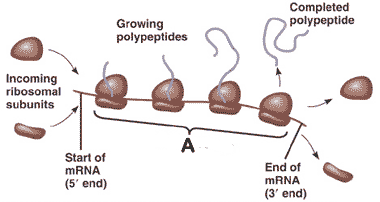(c) Transcription of DNA into primary and mature RNA transcripts to include the role of RNA polymerase and complementary base pairing. The introns of the primary transcript of mRNA are non-coding and are removed in RNA splicing. The exons are coding regions and are joined together to form mature transcript. This process is called RNA splicing.
(d) Translation of mRNA into a polypeptide by tRNA at the ribosome.
tRNA folds due to base pairing to form a triplet anticodon site and an attachment site for a specific amino acid. Triplet codons on mRNA and anticodons translate the genetic code into a sequence of amino acids. Start and stop codons exist. Codon recognition of incoming tRNA, peptide bond formation and exit of tRNA from the ribosome as polypeptide is formed.
 |
(Sources: DNA Transcription By: Suzanne Clancy, Ph.D. © 2008 Nature Education, RNA Splicing: Introns, Exons and Spliceosome By: Suzanne Clancy, Ph.D. © 2008 Nature Education and Translation: DNA to mRNA to Protein By: Suzanne Clancy, Ph.D. & William Brown, Ph.D. (Write Science Right) © 2008 Nature Education)
The genes in DNA encode protein molecules, which carry out all the functions necessary for life including enzymes and structural proteins.
The term gene expression means the cell manufacturing the protein encoded by that gene. As a result of differentiation in cells, not all genes are expressed at all times.
Proteins synthesis has two steps.
1. Transcription
2. Translation
1. Transcription (the details of the spliceosome are outside the scope of the Higher course)
During this stage, the information in DNA is first transferred to a messenger RNA (mRNA) molecule. The DNA of the gene serves as a template for complementary base-pairing, and RNA polymerase enzyme forms a pre-mRNA molecule using free RNA nucleotides. Transcription is initiated at a region of the DNA called the promtoer. This is a short sequence which the RNA ploymerase binds to. Transcription is halted when the RNA ploymerase enzyme encounters a terminator sequence in the DNA, again a short sequence of bases.
Diagrammatic representation of a gene.
The DNA needs to be unwound for transcription to occur, and is rewound after transcription. As with DNA polymerase, RNA polymerase can only add nucleotides to the 3′ end of the growing strand, so transcription is from only one side of the DNA strand.
 The resulting mRNA is a single-stranded complementary copy of the gene (with uracil instead of thymine), which is translated by the ribosome, into a protein molecule.
The resulting mRNA is a single-stranded complementary copy of the gene (with uracil instead of thymine), which is translated by the ribosome, into a protein molecule.
2. Translation
During translation, the mRNA is “read” according to the genetic code, which relates the DNA sequence to the amino acid sequence in proteins (see below). Each group of three base pairs in mRNA constitutes a codon, and each codon specifies a particular amino acid (hence, it is a triplet code). The mRNA sequence is thus used as a template to assemble—in order—the chain of amino acids that form a protein.
This process occurs on the ribosomes. The ribsomes are made of protein and rRNA and have three binding sites, E, P and A. The E site is where the used tRNA is released from, the P site holds the tRNA with the growing amino acid chain and the A site is where the next tRNA with attached amino acid comes into.
Translation starts when a ribsome attaches to the mRNA molecule at the start codon on the mRNA. An initiator tRNA occupies the P site, leaving the second binding site, the A site, open. When a new tRNA molecule recognizes the next codon sequence on the mRNA, it attaches to the open A binding site. A peptide bond forms connecting the amino acid attached to the tRNA in the P site to the amino acid attached to the tRNA in the A binding site.
As the ribosome moves along the mRNA molecule, the tRNA in the P site is moved to the E site and released and the tRNA in the A site is moved to the P site. The A binding site becomes vacant again until another tRNA that recognizes the new mRNA codon takes the open position. This pattern continues as molecules of tRNA are released from the complex, new tRNA molecules attach, and the amino acid chain grows. The ribosome will translate the mRNA molecule until it reaches a stop codon on the mRNA.
Polyribosomes
Polyribosomes (or polysomes) are formed when a cell translates a number of proteins from the same mRNA sequence at the one time. This allows the protein to be produced at a much faster rate.





